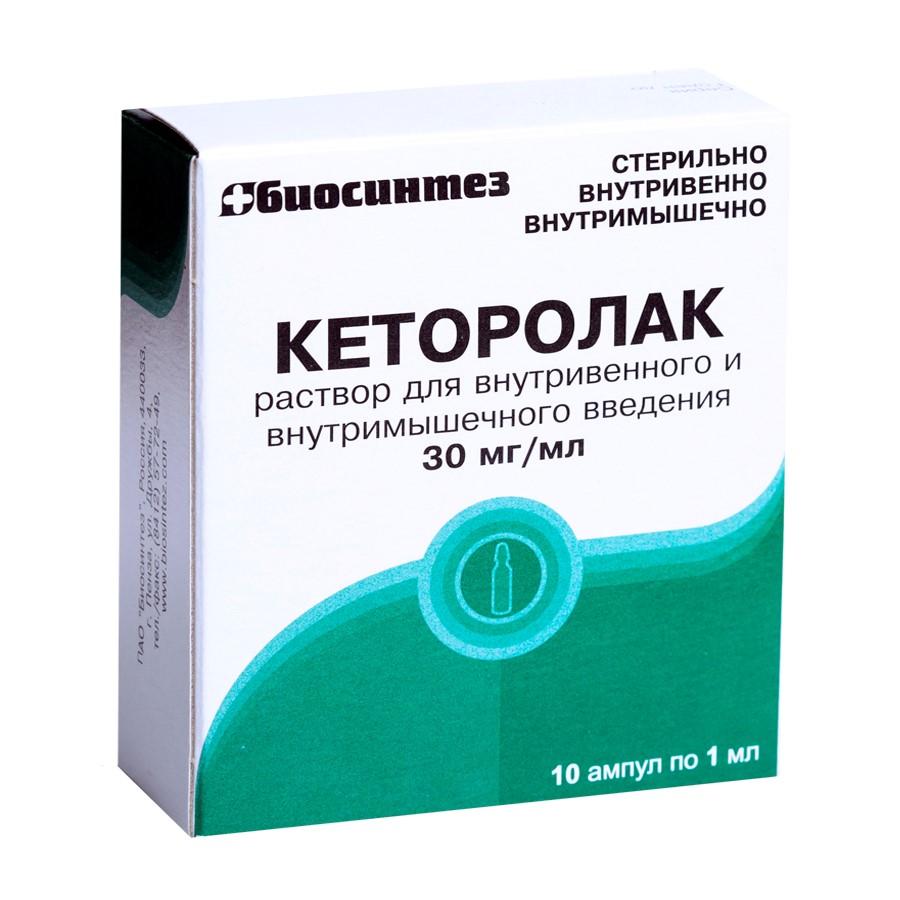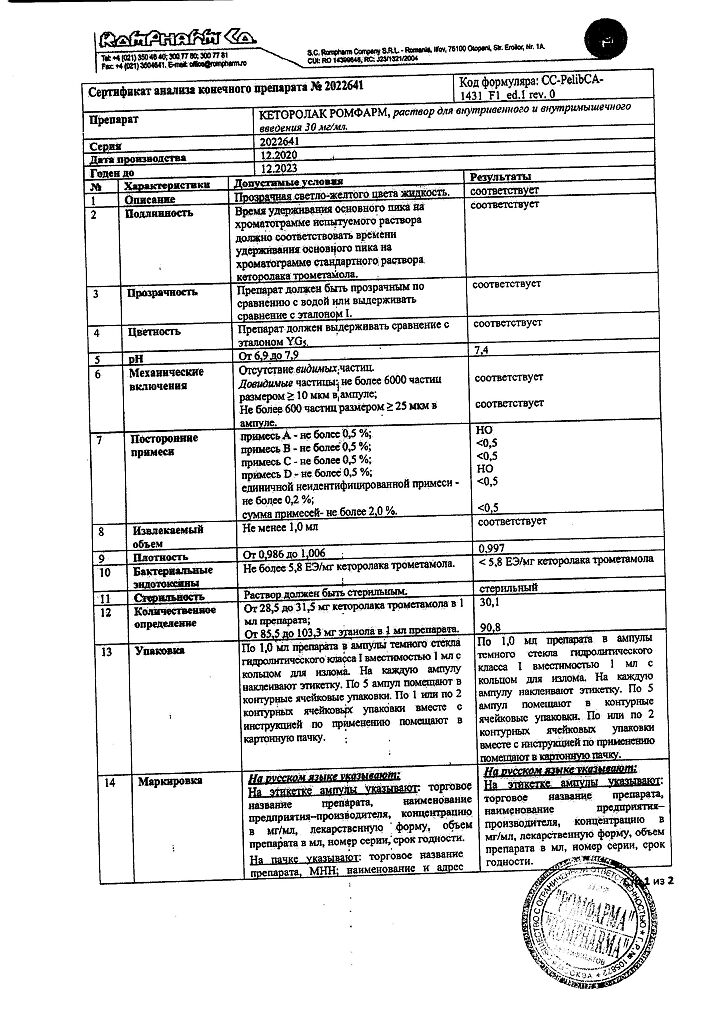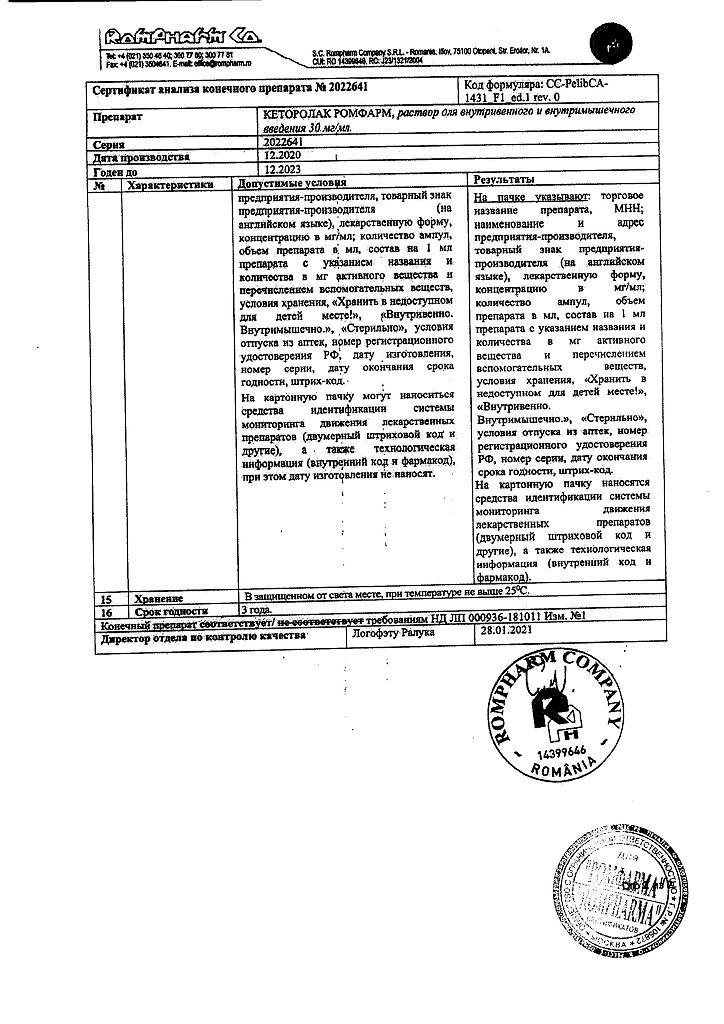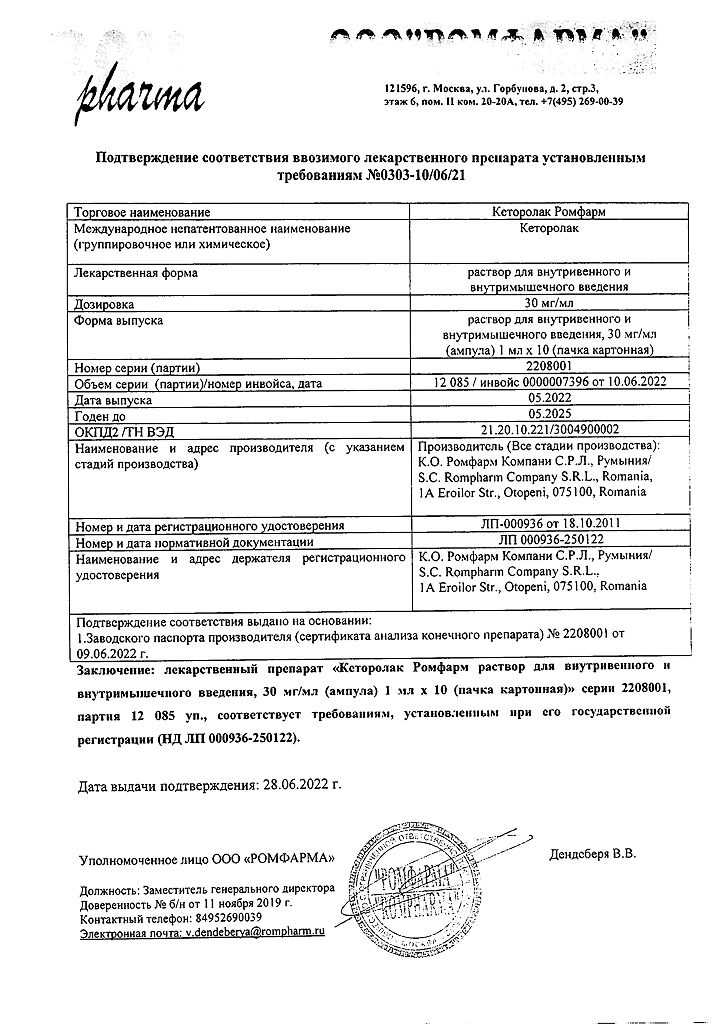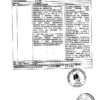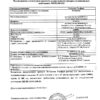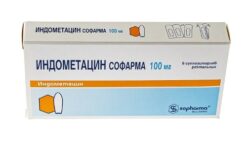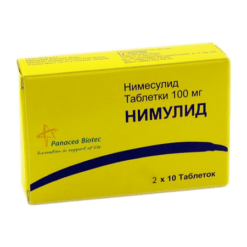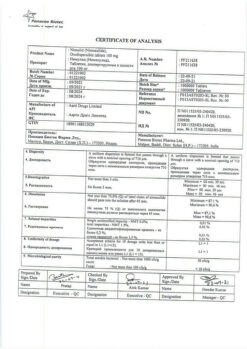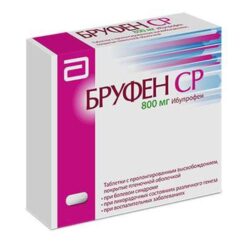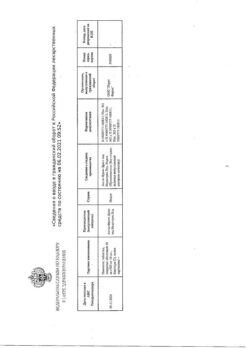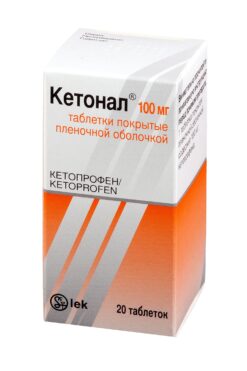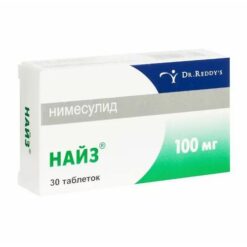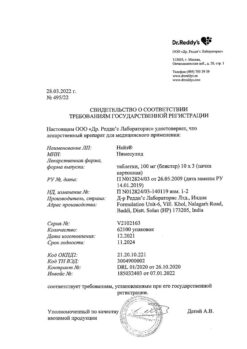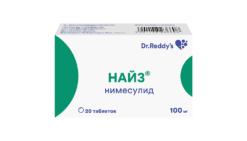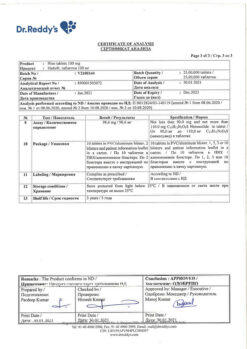No products in the cart.
Ketorolac Rompharm, 30 mg/ml 1 ml 10 pcs
€3.88 €3.53
Description
Ketorolac has a pronounced analgesic effect, also has anti-inflammatory and moderate antipyretic effects.
The mechanism of action is associated with non-selective inhibition of cyclooxygenase 1 and 2 enzyme activity, mainly in peripheral tissues, the consequence of which is inhibition of prostaglandin biosynthesis – modulators of pain sensitivity, thermoregulation and inflammation. Ketorolac is a racemic mixture of [-]S and [+]R enantiomers, and the analgesic effect is due to the [-]S form.
It is comparable to morphine in its analgesic effect and is considerably superior to other non-steroidal anti-inflammatory drugs.
The drug does not affect opioid receptors, does not depress respiration, does not cause drug dependence, does not have sedative and anxiolytic effects. After intramuscular administration the onset of analgesic effect is observed after 0.5 hours, the maximum effect is reached after 1-2 hours.
Indications
Indications
Pain syndrome of severe and moderate severity:
injuries,
toothache,
pain in the postoperative period,
oncological diseases,
myalgia,
arthralgia,
neuralgia,
radiculitis,
dislocations,
sprains,
rheumatic diseases.
Intended for symptomatic therapy, reducing pain and inflammation at the time of use, does not affect the progression of the disease.
Pharmacological effect
Pharmacological effect
Ketorolac has a pronounced analgesic effect and also has anti-inflammatory and moderate antipyretic effects.
The mechanism of action is associated with non-selective inhibition of the activity of the enzyme cyclooxygenase 1 and 2, mainly in peripheral tissues, resulting in inhibition of the biosynthesis of prostaglandins – modulators of pain sensitivity, thermoregulation and inflammation. Ketorolac is a racemic mixture of [-]S and [+]R enantiomers, and the analgesic effect is due to the [-]S form.
The strength of the analgesic effect is comparable to morphine, significantly superior to other non-steroidal anti-inflammatory drugs.
The drug does not affect opioid receptors, does not depress respiration, does not cause drug dependence, and does not have a sedative or anxiolytic effect. After intramuscular administration, the onset of analgesic effect is noted after 0.5 hours, the maximum effect is achieved after 1-2 hours.
Special instructions
Special instructions
When used together with other non-steroidal anti-inflammatory drugs, fluid retention, cardiac decompensation, and arterial hypertension may occur. The effect on platelet aggregation ceases after 24-48 hours.
Hypovolemia increases the risk of developing adverse reactions from the kidneys. If necessary, can be prescribed in combination with narcotic analgesics.
Ketorolac is not recommended for use as a means for premedication, maintenance of anesthesia and pain relief in obstetric practice.
Do not use simultaneously with paracetamol for more than 5 days. Patients with blood coagulation disorders are prescribed the drug only with constant monitoring of the platelet count, especially in the postoperative period, which requires careful monitoring of hemostasis.
It is recommended to avoid performing work that requires increased attention and quick reaction (driving vehicles, working with machinery, etc.).
Active ingredient
Active ingredient
Ketorolac
Composition
Composition
1 ml of injection solution contains:
active ingredient:
ketorolac trometamol (ketorolac tromethamine) – 30 mg.
Pregnancy
Pregnancy
Ketorolac is contraindicated during pregnancy, breastfeeding and children under 16 years of age.
Contraindications
Contraindications
erosive and ulcerative lesions of the gastrointestinal tract,
bleeding from the gastrointestinal tract in the past,
“aspirin” asthma,
hypersensitivity to non-steroidal anti-inflammatory drugs,
severe liver and/or renal failure (creatinine clearance less than 30 ml/min),
hemorrhagic stroke (confirmed or suspected), hemorrhagic diathesis, hematopoiesis disorder.
The drug is not used for pain relief before and during surgery due to the high risk of bleeding, as well as for the treatment of chronic pain.
Side Effects
Side Effects
Often – more than 3%, less often – 1-3%, rarely – less than 1%.
From the digestive system: often (especially in elderly patients over 65 years of age with a history of erosive and ulcerative lesions of the gastrointestinal tract) – gastralgia, diarrhea; less often – stomatitis, flatulence, constipation, vomiting, feeling of fullness in the stomach; rarely – nausea, erosive and ulcerative lesions of the gastrointestinal tract (including with perforation and/or bleeding – abdominal pain, spasm or burning in the epigastric region, blood in the stool or melena, vomiting with blood or coffee grounds, nausea, heartburn, etc.), cholestatic jaundice, hepatitis, hepatomegaly, acute pancreatitis.
From the urinary system: rarely – acute renal failure, lower back pain with or without hematuria and/or azotemia, hemolytic-uremic syndrome (hemolytic anemia, renal failure, thrombocytopenia, purpura), frequent urination, increased or decreased urine volume, nephritis, edema of renal origin.
From the senses: rarely – hearing loss, ringing in the ears, visual impairment (including blurred visual perception).
From the respiratory system: rarely – bronchospasm or dyspnea, rhinitis, pulmonary edema, laryngeal edema (shortness of breath, difficulty breathing).
From the side of the central nervous system: often – headache, dizziness, drowsiness, rarely – aseptic meningitis (fever, severe headache, convulsions, stiffness of the neck and/or back muscles), hyperactivity (mood changes, anxiety), hallucinations, depression, psychosis.
From the cardiovascular system: less often – increased blood pressure, rarely – fainting.
From the hematopoietic organs: rarely – anemia, eosinophilia, leukopenia.
From the hemostasis system: rarely – bleeding from a postoperative wound, nosebleeds, rectal bleeding.
From the skin: less often – skin rash (including maculopapular rash), purpura, rarely – exfoliative dermatitis (fever with or without chills, redness, thickening or peeling of the skin, swelling and/or tenderness of the tonsils), urticaria, Stevens-Johnson syndrome, Lyell’s syndrome.
Local reactions: less often – burning or pain at the injection site.
Allergic reactions: rarely – anaphylaxis or anaphylactoid reactions (change in facial skin color, skin itching, tachypnea or dyspnea, swelling of the eyelids, periorbital edema, shortness of breath, difficulty breathing, heaviness in the chest, wheezing).
Other: often – swelling (face, legs, ankles, fingers, feet, weight gain); less often – increased sweating, rarely – swelling of the tongue, fever.
Interaction
Interaction
The simultaneous use of ketorolac with acetylsalicylic acid or other non-steroidal anti-inflammatory drugs, calcium preparations, glucocorticosteroids, ethanol, corticotropin can lead to the formation of ulcers of the gastrointestinal tract and the development of gastrointestinal bleeding.
Co-administration with paracetamol increases nephrotoxicity, and with methotrexate – hepato- and nephrotoxicity. Co-administration of ketorolac and methotrexate is possible only when using low doses of the latter (monitor the concentration of methotrexate in the blood plasma).
With the use of ketorolac, the clearance of methotrexate and lithium may decrease and the toxicity of these substances may increase. Co-administration with indirect anticoagulants, heparin, thrombolytics, antiplatelet agents, cefoperazone, cefotetan and pentoxifylline increases the risk of bleeding.
Reduces the effect of antihypertensive and diuretic drugs (the synthesis of prostaglandins in the kidneys decreases). When combined with opioid analgesics, the doses of the latter can be significantly reduced, as their effect is enhanced. The hypoglycemic effect of insulin and oral hypoglycemic drugs increases (dose recalculation is necessary).
Co-administration with valproic acid causes disruption of platelet aggregation. Increases the plasma concentration of verapamil and nifedipine.
When prescribed with other nephrotoxic drugs (including gold preparations), the risk of developing nephrotoxicity increases. Probenecid and drugs that block tubular secretion reduce the clearance of ketorolac and increase its concentration in the blood plasma.
The injection solution should not be mixed in the same syringe with morphine sulfate, promethazine and hydroxyzine due to precipitation.
Pharmaceutically incompatible with tramadol solution and lithium preparations. The injection solution is compatible with 0.9% sodium chloride solution, 5% dextrose solution, Ringer’s solution and Ringer-lactate, Plasmalit solution, as well as infusion solutions containing aminophylline, lidocaine hydrochloride, dopamine hydrochloride, short-acting human insulin and heparin sodium salt.
Overdose
Overdose
Symptoms (with a single dose): abdominal pain, nausea, vomiting, erosive and ulcerative lesions of the gastrointestinal tract, impaired renal function, metabolic acidosis.
Treatment: symptomatic (maintaining vital functions of the body). Dialysis is ineffective.
Storage conditions
Storage conditions
In a place protected from light, at a temperature not exceeding 25 °C
Shelf life
Shelf life
3 years
Manufacturer
Manufacturer
K.O.Rompharm Company S.R.L., Romania
Additional information
| Shelf life | 3 years |
|---|---|
| Conditions of storage | In a light-protected place, at a temperature not exceeding 25 °C |
| Manufacturer | C.O.Rompharm Company S.R.L., Romania |
| Medication form | solution |
| Brand | C.O.Rompharm Company S.R.L. |
Related products
Buy Ketorolac Rompharm, 30 mg/ml 1 ml 10 pcs with delivery to USA, UK, Europe and over 120 other countries.

